Let's start the fight against moles
1. What moles eat and how their underground housing is arranged.
2. What attracts animals to our dachas.
3. What to do to prevent moles from coming to the site.
4. How to get rid of moles using folk methods
5. The most effective methods
6. How moles live in winter.
For summer residents, moles are unwanted neighbors in their summer cottage, from whom they want to get rid of as quickly as possible.Moles, busy searching for food, are able to shovel the entire area, including lawns, flower beds and vegetable beds. And then numerous earthen hills - molehills - appear on the lawn or lawn, and plants with undermined roots may be in danger of death. There is only one way out - to get rid of moles by any possible means. Fighting moles is not an easy task and requires a comprehensive solution.
In fairness, it is necessary to note the useful activities of the animals. By laying a network of tunnels, they improve the oxygen saturation of the soil. Water does not stagnate on the surface and seeps through dug wells to the roots of plants. This is especially good for heavy clay soils. In addition, moles eat a large number of harmful insects and their larvae.
What do moles eat and how do their passages work?
Moles are insectivorous animals. The basis of their diet is earthworms; they not only eat them in large quantities, but also store them for the winter. The mole bites the head of the victim, thereby immobilizing him and storing him in the hole. Such winter stocks may consist of hundreds of immobilized individuals.
The extermination of beneficial earthworms is one of the reasons why gardeners want to get rid of moles on their plots. Although scientists do not believe that moles are capable of causing irreparable damage to the population. The number of individuals per hectare reaches 250 thousand.
They also eat mole crickets, larvae of the cockchafer and beetle. Slugs, woodlice, millipedes and spiders also form part of the diet. If a sedentary mouse, lizard or frog gets in the way, the mole will eat them too. The weight of food eaten per day is equal to the weight of the mole. Without food they die within 14-17 hours.
To provide itself with food, the mole digs feeding passages; they form an extensive network and are located horizontally at a depth of up to 5 cm. In areas with compacted, dry soil, the passage goes deep up to 10-50 cm. Excess soil is thrown out through vertical holes, forming so-called molehills. The smell of mole musk attracts prey. Moving through the tunnels, the animal eats prey that is trapped.
The mole's nest is located at a depth of up to 2 m in a protected place, somewhere under trees or bushes, under stones or stumps. The nest is connected to the feeding passages by inclined passages.
It is important to understand that moles do not feed on tubers, root vegetables, bulbs and roots. Either voles or mole voles and other rodents are to blame for the destruction of your crop. His fault is that when digging holes, he sometimes undermines the roots, which can lead to the death of the plant. In addition, mole holes can be used by the same rodents.
What attracts “diggers” to our dachas.
When caring for the plantings at our summer cottage, we dig up the garden, add compost and humus, and water it regularly. Thanks to our efforts, the soil becomes loose, rich in organic matter and moist. There are a lot of earthworms in cultivated soil, and they are the main mole diet.
In addition, various insects crawl and flock to our gardens. Khrushchev larvae, click beetles and other insects, mole crickets, slugs, and woodlice complete the food supply. All this abundance attracts tireless diggers to our dachas.
You are not in danger of being close to moles if the site has a high level of groundwater or sandy soils in which there are practically no worms.Nor will he live in land tormented by the excessive use of chemicals, because there will be no food for him there.
What to do to prevent pests from coming to the site.
The mole lives alone. He is attached to his territory and jealously guards the borders from strangers, leaving special odorous marks. Typically the area of the territory is 600 – 1000 square meters. It can be very difficult to get rid of a mole, because it is not easy for him to find a free area from which the angry owner will not chase him. And even when the mole is expelled or destroyed, a new “master” will immediately come to the vacated territory.
And if a female settles in your dacha and breeds offspring, it will be almost impossible to drive her out. In a good way, she will not leave her cubs until they go into independent life.
What to do?
The conclusion suggests itself: it is easier to prevent the appearance of diggers in your summer cottage than to spend a long and painful time getting rid of them.
Measures to prevent the appearance of uninvited guests on the site:
- There is a time-consuming and expensive, but very reliable method that will save you from annoying neighbors for a long time. To protect the dacha, you need to dig a mesh with a mesh size of no more than 25 mm along the boundaries of the site. It is better to give preference to polymer mesh, it is more durable than metal mesh. In a dug trench with a depth of at least 80 cm, a mesh is installed of such a height that the upper edge is 20–30 cm above the surface level, no less. The fence will save you not only from these but also other harmful rodents.
- The next method is to lay a strip foundation around the site with a depth of at least 80 cm and install a fence. It is clear that this is expensive and time-consuming.But the fence will solve the mole problem forever. And it won’t be easy for other rodents to get into your area.
Of course, while the fence is being installed, you need to catch or drive away the diggers living on the site, if they have already settled in your area. There are many options for getting rid of uninvited guests. How effective they are is determined by everyone in practice.
Traditional methods of fighting moles (not very effective)
Moles have always lived next to people and have always disturbed people. Therefore, people have come up with many ways to get rid of annoying “neighbors.” Here are some of these folk remedies.
How to get rid of moles using noise repellers.
You can install homemade turntables and noisemakers around the perimeter and inside the site. Plastic bottles and cans are used, in which holes are cut and blades are bent. Mounted on a metal pin, such structures rattle and rattle at the slightest breath of wind.
Some gardeners dig in glass bottles at an angle. The wind creates a hum in an empty bottle. It is believed that moles with sensitive hearing get scared and leave the area.
The advantage of these methods is the low cost of available materials, ease of manufacture and use.
Disadvantages - to get results there must be a lot of noisemakers around the perimeter and not only; constant noise will irritate not only the animals, but also the owners; the abundance of structures greatly spoils the appearance of the site.
Summer residents have differing opinions regarding the usefulness of the method. But considering that moles live quietly along railways, we can conclude that even strong noise does not particularly bother them.
We fight moles with the help of plants.
There is an opinion that moles cannot stand the presence of certain plants in the country.
- For example, you can plant black beans around the perimeter of your garden.
- Imperial hazel grouse, marigold, onion garlic.
- Cypress spurge and spurge spurge are believed to repel rodents. All parts of milkweed contain poisonous milky sap.
- Castor oil contains castor oil, and its smell repels animals. Castor beans are very poisonous, especially the seeds.
According to reviews from summer residents, in practice this method of fighting moles is not always effective. It is better to use it in combination with other methods.
Refusal by strong odors
The mole has a highly developed sense of smell, with which it searches for food. Hoping to get rid of the mole, summer residents place disgustingly smelling rotten pieces of fish or meat, and rotten eggs in the aisles. Rags soaked in kerosene, antifreeze, and fuel oil are also used. Naphthalene and castor oil are used. There are a lot of options, but the effectiveness of these methods, if any, is short-lived. The animal simply buries the foul-smelling corridor and begins to dig new holes.
The product is sold in stores Detia. Balls smelling of lavender are placed in the garden at a distance of 1 m. It turns out that the aroma of lavender is unpleasant for moles’ sense of smell and they avoid such places. The balls are harmless to humans and domestic animals.
Means Mole thrower Contains garlic extract. Granules are applied to a depth of 20-30 cm in the pest’s habitat. The pungent garlic “aroma” irritates the animal’s sense of smell and interferes with its search for food.
Repelling a mole with odors requires patience from the summer resident and constant renewal of odorous substances, since they tend to evaporate. Only practice will show how effectively the method will work for you.
Filling molehills with water
You need to find the entrance to the hole and fill it with water from a hose. The method was found to be ineffective. The mole, of course, will leave the flooded passages. But the water will quickly seep deep into the soil, and the area will dry out. The mole will return to its territory after some time.
There are many more folk ways to fight moles. Some of them are very labor-intensive and even dangerous (for example, they pump gas into dug tunnels and then set them on fire), and some can make even the moles themselves laugh (they bury electronic alarm clocks in the ground and they ring there every morning). Unfortunately, the methods described are unlikely to help you get rid of these cute pests forever.
The most effective ways to fight moles
As practice has shown, the most effective ways to combat moles on the site are ultrasonic repellers and old, old-fashioned traps and traps. All other methods are ineffective.
Getting rid of moles using traps
There are many different traps and traps on sale that are installed in existing passages. You can find the current move by digging up a fresh molehill. You need to dig carefully so as not to miss the two entrance holes. Install a mole trap pipe in this place, cover the top with a piece of plywood and sprinkle with earth.
Another way: dig a hole between two holes and place a saucepan or three-liter jar in it just below the stroke level. Cover this area with a piece of plywood or slate and sprinkle with earth.Crawling through the tunnel, the mole will inevitably fall into the container. Traps need to be checked as often as possible, because without food the mole dies within 14-17 hours.
Caught animals must be taken as far as possible from the site, at least 1-1.5 km, so that they cannot return.
This method is quite effective, but if there are many moles in the vicinity, then instead of the one caught, his relatives will come to the vacated territory. Then everything must be repeated all over again.
The use of poisons in the war against moles is dangerous for pets and poisons the soil on the site. Before spreading poison on the site, it is worth considering other methods.
Modern mole repellers.
An effective and safe way to get rid of moles is to use modern repellers. Repellent devices are divided according to their operating principle into sound, vibration and combined.
- The sonic repeller periodically produces sounds that frighten pests. Repellers that emit sounds of variable frequency and duration will be more effective. This prevents the animal from becoming accustomed to noise, which causes discomfort and anxiety. As a result, the animals leave the affected area. Devices that generate sound of the same frequency and duration are less effective.
- The vibration repeller produces periodic low-frequency vibrations. Constant microshocks force the mole to leave the dangerous territory. Wells, pits, and structures on the foundation located on the site will prevent the widespread spread of vibrations. This factor must be taken into account and, if necessary, several devices must be installed.
- A combined repeller combines sound and vibration effects on the ground.It emits sounds and vibrations of different frequencies at different intervals. As a result of prolonged exposure to noise and ground shaking, animals begin to experience stress and are forced to leave the dangerous area.
Combined type devices help fight moles quite effectively.
Today there is quite a large selection on sale: EcoSniper, Tornado, Skat, Chiston, etc. Reviews about the effectiveness are very different, but the majority are positive.
What you need to pay attention to when purchasing a repeller:
- Devices that generate sounds and vibrations of variable frequency and duration are preferred. The random mode of operation eliminates addiction to negative effects and is more effective.
- Solar-powered repellers are more suitable for southern regions with predominantly sunny, clear weather. If summer does not spoil you with sunny days, it is safer to purchase battery-powered devices.
- A repeller in an aluminum case will last longer than a plastic one. When purchasing, evaluate the tightness of the assembly and the presence of microcracks on the body.
- Do not buy cheap, low-power counterfeits from dubious manufacturers.
As a rule, several repellers are installed on the site with a distance between them of 25-30 m. To ensure guaranteed disposal of moles, it is important to follow the instructions and operating rules when installing.
How moles live in winter.
In winter, moles do not hibernate, but continue to lead an active lifestyle. With the onset of frost, they live a little deeper, where the ground does not freeze and there is something to feed on. In addition, animals store large amounts of food for the winter. The mole bites the earthworm's head, thereby immobilizing it. The result is “live canned food”.
In mole pantries, scientists found up to five hundred paralyzed worms. And a mole has several storerooms.
The animals also dig tunnels under the snow, looking for wintering insects and larvae under fallen leaves and in the top layer of soil.
But if the winter turns out to be little snow and harsh, then the moles have a hard time. Without snow cover, the ground freezes to great depths, which greatly complicates the search for food. In frosty winters, many of them die from hunger.
Another popular way to control pests. I don’t know if it will help you get rid of the mole or not, but it will definitely charge you with positivity. Enjoy watching.
You might be interested in:
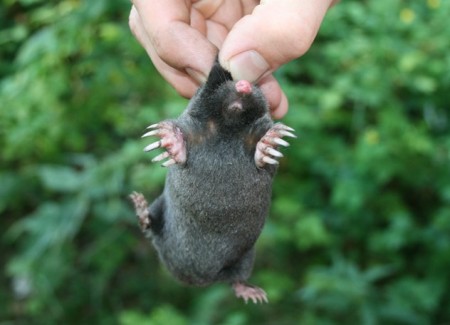
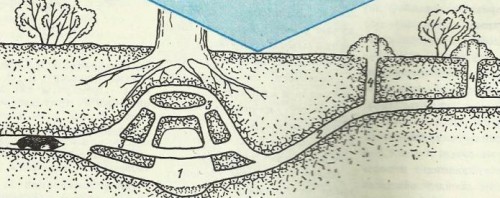

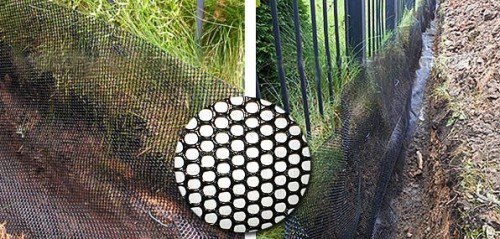



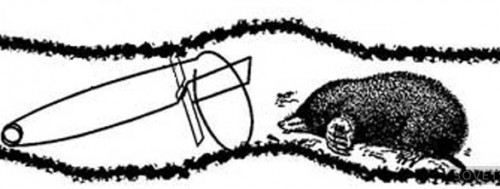
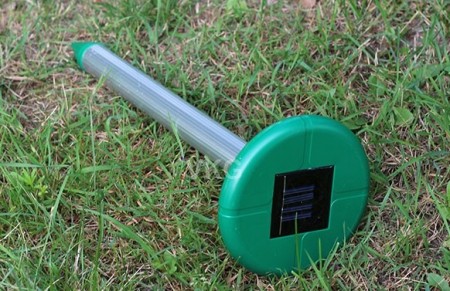


 CUCUMBERS NEVER GET SICK, I'VE BEEN USING ONLY THIS FOR 40 YEARS! I SHARE A SECRET WITH YOU, CUCUMBERS ARE LIKE THE PICTURE!
CUCUMBERS NEVER GET SICK, I'VE BEEN USING ONLY THIS FOR 40 YEARS! I SHARE A SECRET WITH YOU, CUCUMBERS ARE LIKE THE PICTURE! You can dig a bucket of potatoes from each bush. Do you think these are fairy tales? Watch the video
You can dig a bucket of potatoes from each bush. Do you think these are fairy tales? Watch the video
 How our fellow gardeners work in Korea. There is a lot to learn and just fun to watch.
How our fellow gardeners work in Korea. There is a lot to learn and just fun to watch. Eye trainer. The author claims that with daily viewing, vision is restored.They don't charge money for views.
Eye trainer. The author claims that with daily viewing, vision is restored.They don't charge money for views. A 3-ingredient cake recipe in 30 minutes is better than Napoleon. Simple and very tasty.
A 3-ingredient cake recipe in 30 minutes is better than Napoleon. Simple and very tasty. Therapeutic exercises for cervical osteochondrosis. A complete set of exercises.
Therapeutic exercises for cervical osteochondrosis. A complete set of exercises. Which indoor plants match your zodiac sign?
Which indoor plants match your zodiac sign? What about them? Excursion to German dachas.
What about them? Excursion to German dachas.